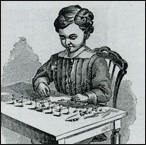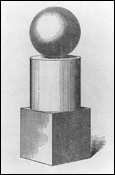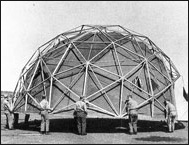Two hundred years ago, a youthful academic named Friedrich Fröbel began to experience the convergence of his primary interests—nature and education. About 30 years later, his pursuits culminated in the creation of kindergarten.
Fröbel viewed nature as a quintessential source of education and the perfect model for design. He also believed in placing students at the center of his pedagogy. Thus, the story of Fröbel’s invention corresponds with the contemporary field of “experience design.”
Now as then
The dawn of the information age has given rise to the notion of an emergent experience economy. In the new era, hallmarks of the industrial age, such as mass production and broadcast media, are giving way to mass customization and interactive media. [1] Examples abound in every corner of the modern marketplace. Internet blogs scoop corporate newsmakers. Fantasy football leagues augment live-action games. And everything from dolls to diamonds can be “made to order.”
The shift in emphasis from purveyance to participation resembles a time of revolutionary change within the field of education. At the beginning of the nineteenth century, a handful of European theorists rejected the purely dispensational tenets of mainstream pedagogy in favor of a trend known as “natural education.” [2]
The new doctrine called for nourishing a child’s innate curiosity through hands-on activity. In turn, proponents transformed the instructor’s role from lecturer to facilitator. They replaced rote learning with object lessons, extended the classroom beyond the walls of the schoolhouse, and encouraged sensory engagement in, and about, the environment.
Planting a children’s garden
Friedrich Fröbel was a charismatic champion of “natural education.” He named his instantiation of the new philosophy “kindergarten” —a combination of the German words for children and garden. His program foreshadowed modern-style multimedia design by integrating gardening, music, dance and storytelling. It also incorporated playful interaction with a series of educational toys. Known as “Fröbel’s gifts,” the toys included building blocks, parquetry tiles, origami papers, modeling clay and sewing kits.
Fröbel’s motto, “Kommt, lasst uns unsern Kindern leben,” anticipated the contemporary notion of user experience design. The phrase, which was translated to “Come let us live for the children,” [3] proclaimed Fröbel’s zeal for nurturing the personal experience of each pupil. Over the past ten years, the emerging experience economy has compelled a growing contingent of professionals to echo Fröbel’s devotion. The new breed of experience designers coordinate interactive systems tailored for people in all walks of life—pupils, patients, parishioners, patrons and so on.

Child learning the proportions of geometrical figures. E. Steiger & Company catalogue, New York, 1900
Body, mind, and spirit
Modern design and business pundits increasingly applaud the benefits of creating optimal “customer experiences” with methodologies ranging from ethnographic studies to usability testing. [4] In the course of designing kindergarten, Fröbel fashioned a pioneering set of “user-centered” design processes. He assessed the cultural conditions of his day, analyzed the psychological motives of young children, and established a set of qualitative metrics.
Before Fröbel invented kindergarten, children under the age of seven where generally deemed to be incapable of learning intellectual or emotional skills. After careful study, Fröbel hypothesized that harnessing the natural impulses of children could ease learning and foster enduring knowledge. He proceeded to cite the significance of “play” in childhood and designed a corresponding curriculum. [5]
Fröbel’s observations about human development were thorough and formal, but not purely clinical. As the son of a Lutheran minister, he spent his own childhood in the garden of his family’s rural property contemplating the order of creation and the human condition from a biblical perspective. The eventual fusion of Fröbel’s scientific methods and his Christian worldview brought forth a unique reverence for human factors. He stood out among his predecessors and peers for his particular recognition of every individual’s physical, intellectual and spiritual make-up.

The forms of Fröbel’s “Second Gift.” E. Steiger & Company catalogue, New York, 1900
Patterns of nature
Fröbel’s holistic regard for people was part of his broader estimation of the entire natural world. As a young adult, Fröbel channeled his passion for nature into academic rigor. In the course of studying geometry, physics, botany, chemistry, and geology he concluded that the patterns of nature provided an ideal template for design.
From 1811 to 1815, Fröbel worked in a university museum categorizing mineral classes by the shapes of crystals. [6] Fröbel’s brief tenure as a crystallographer deepened his belief that there was a crucial correlation between the geometric handiwork of God and the growth of children, adults, and complete societies. In response, Fröbel developed a sequence of educational toys based on the premise that handling forms modeled after the basic units of nature would reveal and illuminate the logic of creation. He subsequently generalized the building block metaphor and used it as the basis for composing each and every facet of his system.
Fröbel established an atomic set of artifacts and activities, then carefully combined them into compound offerings. The resulting system was rich in complexity, yet simple enough for a child to grasp.
Inspired by nature’s inner connectedness, Fröbel coordinated a unified system filled with variety. He symbolized that principled achievement with three geometric forms—a sphere, a cube, and a cylinder. The seamless sphere represented continuity. The faceted cube represented diversity. And the cylinder, simultaneously static and dynamic, represented coherence. [7]

Installation of a magnesium-framed geodesic dome (Design: Buckminster Fuller) Copyright Buckminster Fuller Institute
Organic growth
Fröbel’s ecological design proved to be a potent archetype. Like cell division patterns in an early embryo, the concept of kindergarten flourished in Europe. Shortly thereafter, it rapidly spread to other continents. By the end of the nineteenth century, kindergarten was a familiar institution around the world.
The vast expansion was not controlled by a single entity. When Fröbel died in 1852, he left his followers with volumes of philosophical discourse, but little in the way of practical directives. As a result, knowledge of his system initially spread in a grassroots manner—through apprenticeship and interpretation. By 1890, a sizable publishing industry had grown up around the ideas of Fröbel and his emulators. There were approximately 2,500 literary titles and mass amounts of merchandise from toy manufactures like Milton Bradley. [8]
Over time, kindergarten’s generational impact extended well beyond the education of young children. Fröbel’s innovation was also a major force of growth in the fields of art and design. The students that came of age during the widespread adoption of kindergarten included all of the individuals behind the momentous rise of “Modernism.”
Implicit and explicit traces of Fröbel’s philosophy pervaded the work and teachings of Bauhaus leaders Walter Gropius, Johannes Itten, Josef Albers, Wassily Kandinsky and Paul Klee. Likewise, seminal architects Frank Lloyd Wright and R. Buckminster Fuller specifically cited the importance of their kindergarten experiences. [9] The collective effect of Fröbel’s system on such influential figures revealed a remarkable vitality.
Timeless wisdom
The wisdom of Friedrich Fröbel’s creation rested in a set of timeless design principles. First and foremost, he accounted for the essence of human nature. He then formed intricate, scalable systems from basic elements. Finally, he fertilized growth beyond his original incarnation. Therefore, Fröbel’s historic innovation provides an informative case study for all who endeavor to compose experiential systems in the future.
References
[1] Pine II, B.J. and Gilmore, J.H. (1999) The Experience Economy. Harvard Business School Press. Boston, Massachusetts.
[2] Brosterman, Norman (1997) Inventing Kindergarten. Harry N. Abrams, Incorporated. p.19.
[3] Ibid., p.20.
[4] Nussbaum, Bruce (2004) “Power of Design.” Business Week Magazine (May 17, 2004).
[5] Brosterman, Norman (1997) Inventing Kindergarten. Harry N. Abrams, Incorporated. pp.30-33.
[6] Ibid., p.25.
[7] Ibid., p.46.
[8] Ibid., p.98.
[9] Ibid., R. Buckminster Fuller is quoted on p84. Frank Llyod Wright is quoted on p. 138. The teachings of Walter Gropius, Johannes Itten, Josef Albers, Wassily Kandinsky, and Paul Klee are described on pp. 120-133.
Additional Resources
The Fröbel Kindergarten PhilosophyBill Lucas works at MAYA Design, a consulting firm and technology lab based in Pittsburgh, Pennsylvania. Bill is the inaugural member of MAYA’s Professional Practice Fellowship Program. His current area of focus is user experience design for MAYA’s internal R&D initiatives.
Bill has been designing experiential systems for more than 15 years. During his tenure at MAYA, Bill designed and directed solutions for a wide range of clients including Merrill Lynch, Eaton, General Electric, United States Postal Service, and DARPA (Defense Advanced Research Projects Agency).Prior to joining MAYA, Bill designed identity standards, marketing materials, trade show exhibits and signage systems at Corning Incorporated.
Bill holds a B.S. in graphic design from the University of Cincinnati, where he graduated Summa Cum Laude from the College of Design, Architecture, Art and Planning.

Well I just wanted to let you know I thought about it while I was reading it and it made me think of my own experience in a Montessori program.
I really enjoy connection between design and other sciences. I like your writing style. I find it clear and concise.
The only thing I wanted more of was what started to come out of the last paragraph. I wanted more experience design examples, how clearly similar methodology is being used by designers as part of research and practice. And I think it is funny (while true) that we are comparing users to children. It is smart that we make no assumptions of a user’s skills when designing (and critical) but funny potentially to a layperson not undertsanding that the discipline is designed to honor and not denigrate the user.
In art, the concept of play has pervaded much of current interactive practice. In many ways, artists making work for general audiences are also often useability experts. To develop a compelling interaction, an artist must engage an audience. Since engagement with art is most often voluntary, one trick is to introduce play into any activity, performance, or event. Play and humor are able to take an audience down to a base to facilitate dialogue about tougher issues.
In your example of kindergarten, it seems clear that play is a learning tool. Now what is more obvious to me is that although I work usually on technology systems for generally and “elite†class of user, I struggle to think of them as anything more than their base – a child. I do this when developing art works as well as client “stuff.†So the technology does not matter. If we reduce our device down to a set of primitives, all a user is ever doing is playing with a cube, a cylinder, and a sphere, represented as information.
In experience design we are developing a critical design practice – one that questions the systems as we design for them. We question the compelling nature of the experience. We in fact make technology invisible if all goes well.
Does this make sense? Only partly for me. I think the metaphor, or maybe more precisely the great-grandparent, for experience design he finds in kindergarten is appropriate. I would like to see a more thorough investigation of precise aspects of practice. My hope is that we might start to see even more corollary behavior between the two world/sciences. The rest of what I wrote is perhaps a mess of head spew post burrito lunch.
Take this in stride, I work with Bill (for the past 4 weeks) at MAYA Design.